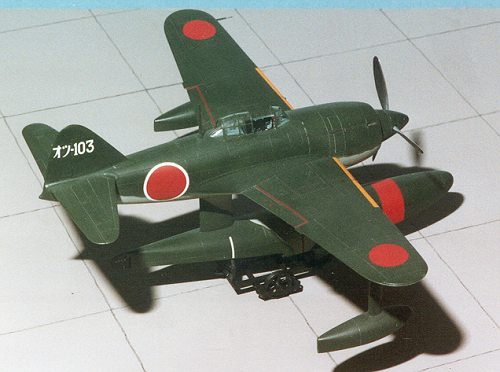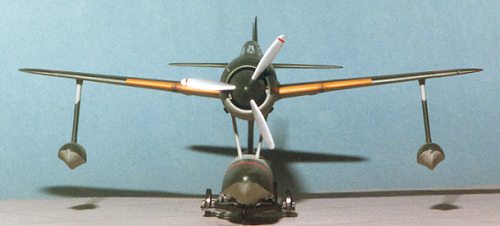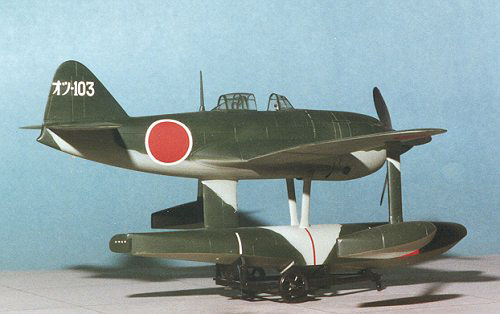
Tamiya 1/48 N1K1 `Rex'
Kit Number: 61036
Price: $34.00
Decals : Three versions, all basically the same
Date of Review: April 1996
Review and Photos by: Scott Van Aken

Editors note. This history section is a June 2000 addition.
 The Japanese
realized early in their planning for the enlarging of their empire during the
late 1930s that there would be a need for fighter protection during amphibious
landings where no carrier or runway was available. It was also needed at the many
islands that were destined to fall under Japanese influence. The fact that many
of these places could not have runways built (for a variety of reasons), or
needed immediate protection while runways were constructed, led to a requirement
for a modern floatplane fighter.
The Japanese
realized early in their planning for the enlarging of their empire during the
late 1930s that there would be a need for fighter protection during amphibious
landings where no carrier or runway was available. It was also needed at the many
islands that were destined to fall under Japanese influence. The fact that many
of these places could not have runways built (for a variety of reasons), or
needed immediate protection while runways were constructed, led to a requirement
for a modern floatplane fighter.
An interim solution was to build a floatplane version of the A6M Zero-sen and Nakajima was tasked with the construction of the A6M2-N. However for a more modern aircraft, Kawanishi, who had a lot of experience in water-borne aircraft, was given the nod to build the aircraft that eventually became the N1K1 Kyofu (Mighty Wind).
Based on information gathered during the design of the E15K1 Shiun, a mid-winged aircraft with a 1,460 hp Mitsubishi Kasei 14 engine driving counter rotating props was designed. First flight was on 6 May 1942, however problems with the gearing on the counter rotating propeller led to the use of a normal three bladed prop. A downside of eliminating the counter rotating prop was a huge amount of torque that required a lot of skill from the pilot.
 Overall,
it was an excellent aircraft in the air. Its qualities on a par with the current
A6M Reisen. Deliveries to units began in the spring of 1943.
Unfortunately, production levels were slow and the last of 97 aircraft was
delivered in March 1944. The decision to stop production was solely based on the
deteriorating war situation and not on any qualities of the aircraft. The N1K1
was successfully turned into one of the best JNAF land fighters of the war. The
Rex was finally destined to provide defense of the oil refineries in Balikpapan,
Borneo and also operated from Lake Biwa in defense of the Japanese
homeland.
Overall,
it was an excellent aircraft in the air. Its qualities on a par with the current
A6M Reisen. Deliveries to units began in the spring of 1943.
Unfortunately, production levels were slow and the last of 97 aircraft was
delivered in March 1944. The decision to stop production was solely based on the
deteriorating war situation and not on any qualities of the aircraft. The N1K1
was successfully turned into one of the best JNAF land fighters of the war. The
Rex was finally destined to provide defense of the oil refineries in Balikpapan,
Borneo and also operated from Lake Biwa in defense of the Japanese
homeland.
One N1K1 is still extant. Though its current whereabouts is unknown, it was on open air display at NAS Willow Grove for a number of years. It is hoped that this aircraft is being restored for inclusion in the Naval Aviation Museum in Pensacola, Florida.
 Tamiya's return to aircraft modeling is very welcomed. They have
always been known for building well engineered kits and the Rex is no exception.
The kit almost built itself. I had no problems of any kind and only used
putty on areas where I gouged the plastic removing it from the trees. The
interior is a gem and the panel detailing is very well done. A nice touch
is a beaching dolly and a nice big weight for the front of the main float.
Tamiya's return to aircraft modeling is very welcomed. They have
always been known for building well engineered kits and the Rex is no exception.
The kit almost built itself. I had no problems of any kind and only used
putty on areas where I gouged the plastic removing it from the trees. The
interior is a gem and the panel detailing is very well done. A nice touch
is a beaching dolly and a nice big weight for the front of the main float.
The only real option is the use of two different exhausts; one straight and one curved. I really like Tamiya's method of trapping the propeller shaft in a plastic bushing. This allows the prop to be added after the rest of the kit is built. It also enables one to take the prop off when transporting the kit. I used the kit decals which are a bit thick, but conform beautifully to all the panel lines.
I can't say enough good about this kit. Very highly recommended to all skill levels.
Copyright ModelingMadness.com. All rights reserved. No reproduction in part or in whole without express permission from the editor.
Back to Reviews Page 2024